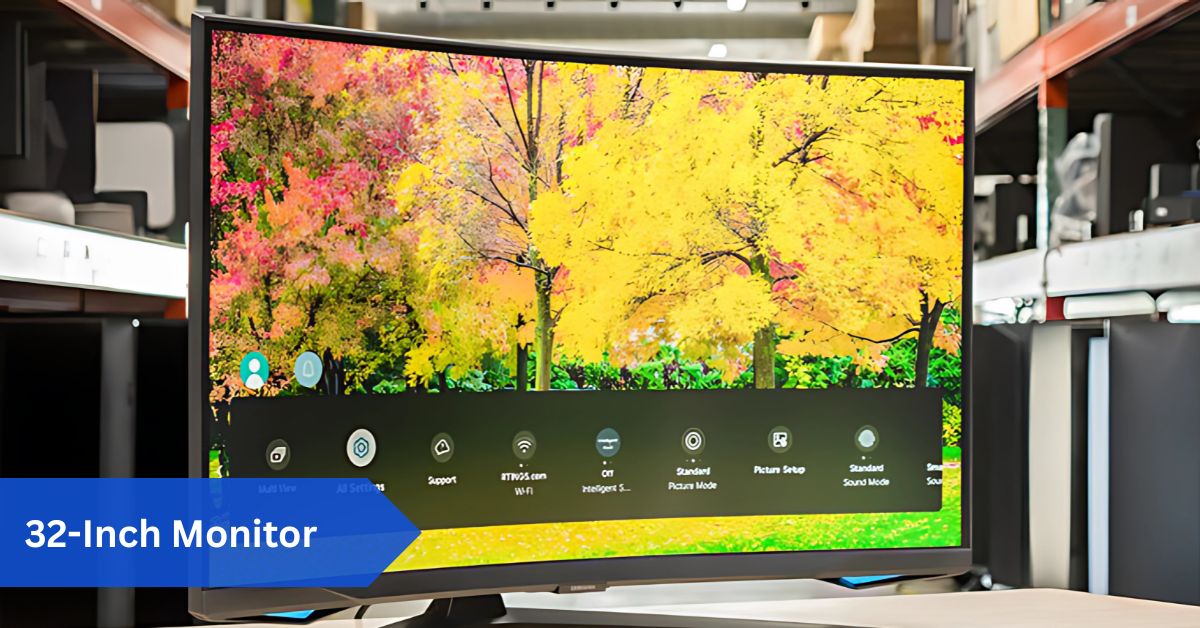Introduction:
Computer monitors have evolved tremendously from the bulky CRTs of the 90s to today’s slim, high-definition displays that redefine how we work, play, and create. Among the many screen sizes available, the 32-inch monitor has become one of the most versatile and sought-after options.
A 32-inch monitor offers the perfect blend of size, clarity, and comfort for gaming, work, and entertainment. With ample screen space and higher resolutions, it enhances multitasking and overall visual immersion without overwhelming your desk.
Its popularity comes from offering the perfect balance between size and comfort. A 32-inch monitor provides immersive viewing without sacrificing practicality, making it ideal for gamers, professionals, content creators, and everyday users. This guide covers everything you need to know, from specs to buying tips, so you can decide if a 32-inch monitor is the right upgrade for you.
What Is a 32-Inch Monitor?
When people refer to a 32-inch monitor, they are typically discussing the diagonal length of the screen—not its width or height. The dimensions of most 32-inch monitors with a standard 16:9 aspect ratio, excluding the stand or bezels, are approximately 27.9 inches in width and 15.7 inches in height.
This size makes the monitor larger than the traditional 24-inch or 27-inch models while remaining practical for desk use. Depending on the resolution, a 32-inch display can provide crystal-clear images and plenty of workspace for multitasking.
It’s not just about size, though. A 32-inch monitor often comes with higher resolutions (1440p or 4K), better refresh rates, and advanced features that make it more than just a bigger screen.
Why Choose a 32-Inch Monitor?
You might be wondering—why should you choose a 32-inch monitor instead of sticking with the more common 27-inch models? Here are a few compelling reasons:
- Better Multitasking – With more screen space, you can easily open multiple windows side by side without feeling cramped. Perfect for professionals handling spreadsheets, coding, or research.
- Immersive Gaming Experience – The larger display enhances immersion, making open-world games feel more cinematic and shooters more engaging.
- Improved Media Viewing – Watching movies or streaming TV shows feels closer to a home theater experience on a 32-inch screen.
- Comfortable Viewing – Unlike ultra-wide monitors that require head-turning, a 32-inch flat or curved screen fits comfortably within your field of vision.
- Future-Proofing – With a 32-inch 4K monitor, you can prepare yourself for the next generation of content that is becoming more and more tailored to larger, high-resolution screens.
:
A 32-inch monitor is versatile and suitable for gaming, work tasks, and entertainment.
The Screen Size Debate: 24″ vs 27″ vs 32″:
Choosing a monitor size is like choosing the right car—you want something that suits your lifestyle and comfort.
- 24-inch monitors – Affordable, compact, great for office work or small desks. But they feel outdated for high-end gaming or creative tasks.
- 27-inch monitors – The current “sweet spot” for many users, offering a balance of size, resolution, and desk-friendliness.
- 32-inch monitors – Bigger, more immersive, and excellent for multitasking. However, they require more desk space and are best paired with higher resolutions.
Think of it like this: a 24-inch is like a compact car, efficient but limited. The 27-inch is a mid-size sedan, versatile for most drivers. 32-inch is the SUV, spacious and powerful, offering more of everything—if you can handle the size.
Types of 32 Inch Monitors:

Not every 32-inch monitor is built the same. They come in different categories depending on their purpose:
1. Gaming Monitors:
- High refresh rates (144Hz, 240Hz, and even 360Hz)
- Low response times (1ms–5ms)
- Support for G-Sync or FreeSync
- Designed for smooth, lag-free gameplay
2. Professional Monitors:
- Focused on color accuracy and calibration
- HDR support for lifelike visuals
- Ideal for graphic designers, video editors, and photographers
3. General-Purpose Monitors:
- Balanced features at a lower cost
- Suitable for browsing, office work, and casual entertainment
By identifying your needs, you can narrow down which type suits you best.
Resolution Options for 32 Inch Monitors:
It can be said that for a large screen, resolution is the most crucial aspect. Let’s break down the options:
- 1080p (Full HD) – On a 32-inch screen, Full HD may look slightly pixelated. It is cost-effective, but not the best option unless you are seated at a distance from the screen.
- 1440p (QHD) – The sweet spot for many. It balances performance and clarity, making it great for gaming and productivity.
- 4K UHD (3840 x 2160) – Offers incredible sharpness and detail. Perfect for professionals and movie lovers, but requires a powerful GPU for gaming.
In simple terms, 1080p is economy class, 1440p is business class, and 4K is first class.
Refresh Rate and Response Time:
For gamers, refresh rate and response time are deal-breakers:
- Refresh Rate (Hz) – The frequency of screen updates each second. A 60Hz monitor is fine for casual use, but gamers often prefer 144Hz or 240Hz for buttery-smooth gameplay.
- Response Time (ms) – The speed at which pixels change their color. A lower value is preferable. In competitive gaming, a response time of 1ms is optimal.
Even outside of gaming, higher refresh rates make everyday use—like scrolling web pages—feel noticeably smoother.
Panel Technologies in 32 Inch Monitors:
The panel type greatly influences picture quality and performance:
- IPS (In-Plane Switching) – Excellent color accuracy and viewing angles. Best for designers and general use.
- VA (Vertical Alignment) – Delivers deep blacks and rich contrast for a cinematic look. The trade-off is that response times can be a bit slower compared to other panel types.
- TN (Twisted Nematic) – Fast and cheap, but weaker colors and angles. Mostly found in budget or competitive gaming monitors.
If budget allows, IPS panels are the gold standard for a well-rounded experience.
Curved vs Flat 32 Inch Monitors:
Curved monitors are designed to mimic the natural curve of your eyes, offering a more immersive viewing experience. A 1500R or 1800R curve is common for 32-inch displays.
- Curved Advantages: Reduced distortion, immersive gaming, and better field of view.
- Flat Advantages: Better for professional tasks requiring precision, easier to mount, and more affordable.
Gamers and movie lovers often prefer curved, while professionals lean toward flat panels.
Ergonomics and Eye Comfort:

Spending hours in front of a 32-inch monitor can strain your eyes and posture. That’s why many modern monitors include:
- Blue light filters help reduce eye strain during long use.
- Flicker-free technology for smoother visuals.
- Height-adjustable stands for better posture.
- VESA mounting options for flexible setups.
Remember, comfort is just as important as specs when choosing a monitor.
Best Uses for a 32 Inch Monitor:
A 32-inch monitor is like a Swiss Army knife—it can serve multiple purposes:
- Gaming – Immersive visuals with wide viewing fields.
- Office Work – Ideal for handling spreadsheets, coding, or video calls.
- Graphic Design & Content Creation – Accurate colors and high resolution benefit creative professionals.
- Movies & Multimedia – Feels like a mini home theater setup.
- Stock Trading – More screen real estate to monitor charts and data simultaneously.
Connectivity Options:
Modern 32-inch monitors often come with a variety of ports:
- HDMI 2.0/2.1 – Common and reliable, supports 4K at 60Hz or 120Hz.
- DisplayPort 1.4 – Ideal for high refresh rates and adaptive sync.
- USB-C – Handles video, data, and power in a single connection.
- Additional Ports – Often include USB hubs, audio jacks, and even Ethernet for easy docking.
A future-proof monitor should have at least HDMI and DisplayPort.
Top Brands Offering 32 Inch Monitors:
For reliability and performance, these brands really stand out:
- Samsung – Famous for curved displays and QLED tech.
- LG – Strong in IPS and OLED monitors.
- Dell (UltraSharp series) – Highly regarded for professional use.
- ASUS ROG & Acer Predator – Tailored for high-end gaming.
- BenQ – Well-balanced for both productivity and entertainment.
Budget vs Premium 32 Inch Monitors:
Like cars, monitors come in different classes:
- Budget ($200–$300) – 1080p, 60Hz, good for basic use.
- Mid-Range ($400–$700) – 1440p or 4K, 120Hz+, versatile for gaming and work.
- Premium ($800+) – 4K HDR, 144Hz+, pro-grade color calibration, and advanced features.
Your choice depends on whether you want an entry-level daily driver or a luxury powerhouse.
Dual Monitor Setup: Is 32 Inch Too Big?

Two 32-inch monitors might sound like overkill, but for stock traders, developers, or video editors, it’s a dream come true. However, for casual users, it may take up too much space. A popular compromise is one 32-inch main monitor with a smaller secondary display.
Wall Mounting vs Desk Setup:
A 32-inch monitor occupies a significant amount of desk space. To optimize:
- Wall Mounting – Saves space, creates a clean look.
- Monitor Arms – Allow flexible positioning and ergonomic adjustments.
- Traditional Stands – Stable but less flexible.
Consider your desk depth—ideally, you want at least 24 inches between your eyes and the screen.
How to Choose the Right 32 Inch Monitor for You:
Here’s a quick buyer’s checklist:
- Primary Use: Gaming, work, movies, or mixed?
- Resolution: 1440p for balance, 4K for clarity.
- Refresh Rate: 60Hz for work, 144Hz+ for gaming.
- Panel Type: IPS for accuracy, VA for contrast.
- Connectivity: HDMI, DisplayPort, USB-C.
- Budget: Entry-level vs premium.
Future of 32 Inch Monitors:
The future is bright for 32-inch displays. Expect innovations like:
- Mini-LED backlighting for improved brightness and HDR.
- OLED panels with perfect blacks and stunning contrast.
- 8K resolution (though still years away for mainstream).
- AI-driven enhancements like automatic color calibration.
As work-from-home culture and immersive gaming grow, the demand for large, versatile monitors will only increase.
Conclusion:
A 32-inch monitor is not just about size—it’s about productivity, immersion, and future readiness whether you’re gaming, designing, working, or simply watching Netflix, this screen size offers a level of comfort and clarity that smaller monitors can’t match.
If you’ve been on the fence, consider your needs, budget, and desk setup. Chances are, once you go 32-inch, you won’t want to go back.
FAQs:
1. Is 32 inches too big for a desk monitor?
Not really. For most desks, it fits fine, especially if you sit 2 feet or more away. It actually enhances productivity since you can see more content without straining your eyes.
2. Is a 32-inch monitor good for gaming?
Yes—especially with high refresh rates and low response times. Many competitive gamers love this size. It provides an immersive field of view, making both casual and competitive gaming more enjoyable.
3. Which resolution looks best on a 32-inch monitor?
While 1440p offers the best compromise between performance and clarity, 4K is perfect if your system can manage it. Higher resolution reduces pixelation, ensuring sharper visuals for work, movies, and games.
4. Is a 32-inch monitor suitable for office tasks?
Absolutely. It allows you to open multiple documents side by side without feeling cramped. With the additional screen space, the necessity to frequently toggle between windows and tabs is diminished.
5. Which brands make the best 32-inch monitors?
Samsung, LG, Dell, ASUS, Acer, and BenQ are all excellent choices depending on your use case. Each brand offers unique features like curved panels, color accuracy, or gaming enhancements.
Read More:
240Hz Monitor: Guide for Gamers, Creators, and Professionals
The Ultimate Guide to 24-Inch Monitors: Everything You Need to Know
The Ultimate Guide to 144Hz Monitors: Everything You Need to Know
Computer Monitor Shadowing Problem: A Complete Guide
Black Line in Monitor: Causes, Fixes, and Prevention
